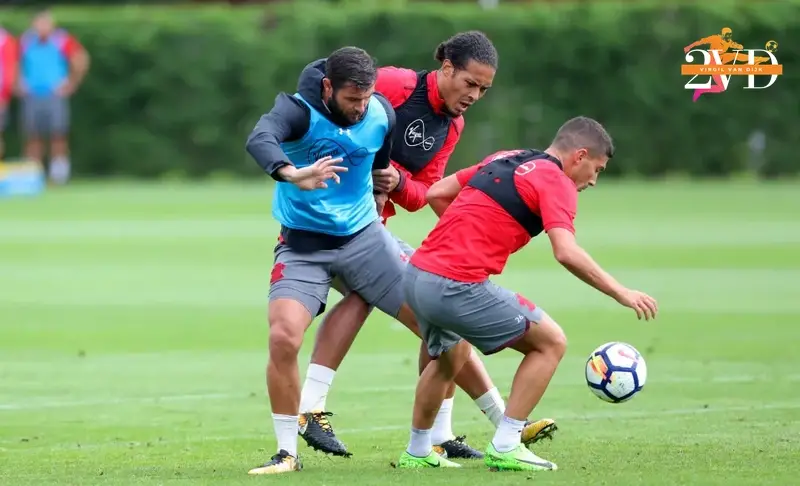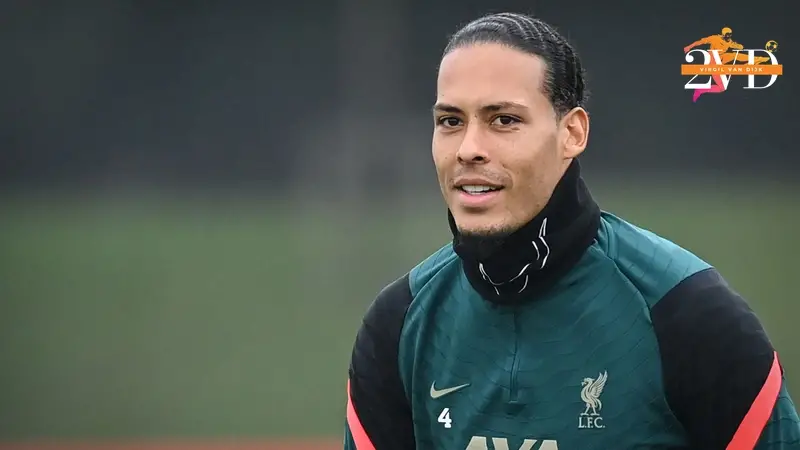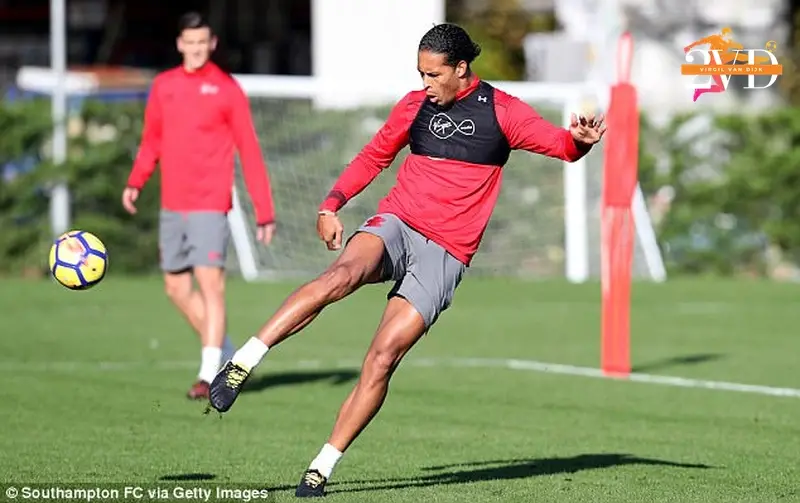Virgil van Dijk‘s training is not just a set of exercises but a carefully designed program aimed at optimal performance and longevity in elite football. It reflects precision, discipline, and a strong commitment to excellence, combining advanced sports science with football’s essential requirements. His impressive skills and defensive expertise stem from a constant dedication to improving all aspects of his game – physical, technical, tactical, and psychological.
From powerful gym workouts to accurate long passes and strategic positioning, each part of his performance is meticulously enhanced through a holistic approach. He relentlessly pursues small improvements, knowing that the gap between good and great comes from attention to detail in preparation, recovery, and mental toughness. His training focuses on working smarter, ensuring he is physically and mentally ready to excel consistently, making him the exceptional central defender he is today.

The Holistic Blueprint of a Modern Defender
Van Dijk’s training is not compartmentalized; it’s a integrated system where each component reinforces the others, creating a supremely balanced and robust athlete. This holistic approach is essential for a player whose role demands physical dominance, technical finesse, and supreme mental fortitude.
Precision in Physical Conditioning
At the core of Van Dijk’s imposing physical presence is an incredibly precise and personalized physical conditioning program. This isn’t just about lifting heavy weights; it’s about building a body that is durable, powerful, and agile enough to withstand the rigours of modern football.
- Strength and Power Development: His gym work focuses heavily on compound movements – squats, deadlifts, bench presses – but critically, these are tailored to enhance functional strength directly applicable to football. This translates into the ability to hold off attackers, win aerial duels, and explode into tackles. Plyometrics, such as box jumps and hurdle hops, are integral to developing his explosive power, crucial for contested headers and rapid acceleration from a standing start. Core stability exercises are also paramount, providing the foundational strength that enables his balance, change of direction, and powerful kicking ability, all while minimizing the risk of injury, especially given his recovery from a significant ACL injury.
- Endurance and Stamina: While not a box-to-box midfielder, a central defender at the elite level still requires immense endurance. Van Dijk’s routine incorporates varied cardiovascular work, including high-intensity interval training (HIIT) sessions that mimic game scenarios – short bursts of maximal effort followed by brief recovery periods. These sessions improve his anaerobic capacity, allowing him to maintain intensity throughout a match, make repeated sprints to cover space, and be available to receive passes. Lower-intensity, longer-duration runs are also included for active recovery and building aerobic base, ensuring his overall cardiovascular fitness remains exceptionally high.
- Speed and Agility: Despite his size, Van Dijk possesses remarkable agility and deceptive speed. His training includes drills specifically designed to improve first-step quickness, lateral movement, and change of direction. This involves cone drills, shuttle runs, and reactive exercises where he must respond quickly to visual cues, simulating the unpredictable nature of defensive situations where he might need to rapidly close down an attacker or adjust his position to block a shot. This meticulous work ensures he can cover ground quickly and pivot efficiently to cut off passing lanes or track opposition forwards.

Mastering the Technical Tactical Canvas
Beyond physical prowess, Van Dijk’s brilliance lies in his technical execution and tactical intelligence, which are continuously honed through specialized on-field work.
- On-Field Drills for Defensive Mastery: His sessions include extensive work on defensive positioning, focusing on angles, body shape, and timing tackles. Drills simulate 1v1, 2v2, and larger defensive scenarios, emphasizing communication and spatial awareness. Aerial dominance is sharpened through repeated heading drills, both offensively (from set pieces) and defensively (clearing crosses). Passing accuracy, especially his renowned long-range distribution, is practiced meticulously, ensuring he can transition play quickly and effectively from defense to attack. These drills extend to ball control under pressure, ensuring he can confidently receive and distribute the ball even when tightly marked.
- Video Analysis and Game Intelligence: A significant, often unseen, part of his training involves extensive video analysis. This isn’t just passive viewing; it’s an active process of dissecting opponents’ attacking patterns, understanding rival strikers’ movements, and analyzing his own performances. This fosters exceptional game intelligence, allowing him to anticipate play, read situations before they fully develop, and make split-second decisions that avert danger. He identifies weaknesses in opposition attacks and strengths in his own defensive setup, continuously refining his tactical understanding.
- Set-Piece Rehearsals: Both offensive and defensive set pieces are rehearsed rigorously. Defensively, this involves practicing zonal and man-marking schemes, understanding assignments, and reacting cohesively to crosses and corners. For offensive set pieces, he works on timing his runs, making contact with the ball, and understanding strategic blocking movements, ensuring he can capitalize on his height and aerial ability to score critical goals or create chances.

Recovery, Nutrition, and Mindset
The glamour of training often overlooks these crucial aspects, yet for Van Dijk, they are the bedrock of consistency and longevity.
- Recovery Protocols: Aggressive training demands equally aggressive recovery. Van Dijk’s routine likely incorporates cryotherapy (ice baths or chambers) to reduce inflammation, various forms of massage therapy for muscle soreness and flexibility, and foam rolling for myofascial release. Active recovery sessions, such as light cycling or swimming, help flush out lactic acid and maintain blood flow. These protocols are meticulously planned to ensure his body recovers optimally between high-intensity training sessions and matches, preventing overtraining and reducing injury risk.
- Nutritional Strategy: An elite athlete’s diet is a powerful training tool. Van Dijk adheres to a highly personalized nutritional strategy, designed by club dietitians. This focuses on adequate protein intake for muscle repair and growth, complex carbohydrates for sustained energy, and healthy fats for overall bodily function. Hydration is constantly monitored, with electrolyte replenishment being key. Supplements, carefully selected and approved, might also play a role in optimizing performance and recovery, ensuring his body has every nutrient required to perform at its peak and recover efficiently.
- Mental Fortitude and Leadership: Perhaps Van Dijk’s most defining quality is his mental strength and leadership. His training extends to psychological conditioning, including visualization techniques to mentally rehearse game scenarios, stress management strategies to remain calm under pressure, and fostering a relentless winning mentality. His ability to communicate, organize the defence, and inspire his teammates on the pitch is a direct result of cultivating strong mental attributes off it. He leads by example, both with his actions and his unwavering focus and composed demeanor, which are products of continuous psychological training.
- Injury Prevention and Rehabilitation: Especially post-ACL injury, injury prevention is woven into every aspect of his routine. This involves specific eccentric loading exercises for tendons and ligaments, proprioceptive training to improve joint stability, and consistent monitoring of muscle imbalances. Should an injury occur, the rehabilitation strategy is equally meticulous, with tailored exercises designed to not just heal, but to bulletproof the affected area, ensuring a safe and strong return to play.

Beyond the Training Ground: A 24/7 Commitment
Van Dijk’s success is not confined to the hours spent at the training facility; it’s an all-encompassing lifestyle commitment.
Lifestyle as an Extension of Training
His daily life outside of formal sessions is meticulously managed to support his athletic pursuits. Sleep hygiene is paramount, ensuring he gets sufficient high-quality sleep to facilitate muscle repair, hormonal balance, and cognitive function. He actively works to minimize external stressors, understanding that mental well-being directly impacts physical performance. This sustained level of dedication means that even his leisure activities, to some extent, are considered through the lens of recovery and maintaining physical readiness. He is constantly engaging in continuous learning and adaptation, whether it’s by adopting new training methodologies, refining his understanding of the game, or embracing technological advancements in sports science.
The “Van Dijk Effect”: Beyond Individual Prowess
The cumulative effect of Van Dijk’s rigorous training manifests not only in his individual excellence but also in his transformative impact on the team. His physical dominance, technical reliability, and tactical intelligence allow him to be a calming and commanding presence, which in turn elevates the performance of those around him. Analogy: likened to the keel of a ship, his stability allows the entire vessel (the team) to navigate turbulent waters with greater confidence. His consistent peak performance instills confidence in his teammates, while his imposing figure and sharp mind pose a significant psychological challenge to opponents. This “Van Dijk Effect” is a direct testament to the discipline and comprehensive nature of his training, enabling him to not just perform, but to lead contagiously and architect success from the heart of the defence.
Dive into the complete story—from his first professional steps to his current captaincy – in the Profile & Career section.
